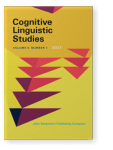Siaw-Fong Chung
List of John Benjamins publications for which Siaw-Fong Chung plays a role.
Articles
2022 Emotion terms in Malay: Patterns in [ meN- ], [ meN‑ -i ], [ meN‑ -kan ], and [‑ kan ]-only forms Language and Linguistics 23:2, pp. 147–190 | Article
This study examined 25 emotion terms in Malaysian Malay and used corpus data to investigate whether these emotion terms appeared with the [meN-], [meN‑ -i], [meN‑ -kan], and [‑kan]-only forms. The emotion terms were patterned in four different ways. Category One included local emotion verbs that… read more
2022 A morphosyntactic and morphosemantic analysis of the Malay fear lexeme Concentric 48:2, pp. 147–173 | Article
For Malay, when no contextual clues are given, a lexical form can be confusing because sometimes it can have more than one meaning. We postulated that most confusing meanings can be disambiguated through observing their morphosyntactic and morphosemantic structures. We used corpus data and… read more
2021 Delimiting durative events with manner: A comparative study of two verbs of rushing in Mandarin Cognitive Linguistic Studies 8:1, pp. 16–59 | Article
Durative events by default are atelic. However, temporal targets are typically required for durative verbs with a rushing manner, such as ‘We are catching the 3:30 flight’ and ‘The farmer rushed to harvest before the storm’. Why and how does manner introduce delimiting temporal concepts to… read more
2020 Direct (dis)agreement verbs: Agree/disagree in native speaker and learner data Journal of Second Language Studies 3:1, pp. 111–140 | Article
“*I am not agree with you” is an incorrect use of agree frequently seen in the writing of Taiwanese learners. Yet, not many studies have discussed the use of agree and disagree in the literature. Many studies are concerned more about the politeness of (dis)agreement, especially in detailing the… read more
2019 Lagi in Standard Malaysian Malay: Its meaning conceptualization Concentric 45:1, pp. 82–111 | Article
Lagi, a less studied Malay adverb, has meanings such as ‘in addition’, ‘again’, ‘more’, and ‘yet/still’. We aimed to see how these meanings could be related in a single word and to find the conceptualization and grammatical paths involved. We also intended to find out whether this word… read more




